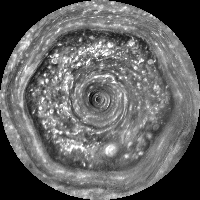
|
In Full View: Saturn’s Streaming Hexagon
- Click the image above for a larger view
 Movie Download Options
Movie Download Options- Full-Res JPEG (1024 x 1024) (109.6 kB)
- Full-Res TIFF (1024 x 1024) (1.1 MB)
Caption:

Click on the gif for the larger black & white animation
This colorful view from NASA's Cassini mission is the highest-resolution view of the unique six-sided jet stream at Saturn's north pole known as "the hexagon." This movie, made from images obtained by Cassini's imaging cameras, is the first to show the hexagon in color filters, and the first movie to show a complete view from the north pole down to about 70 degrees north latitude.
The differences in this version of the movie, in which different wavelengths of light from ultraviolet to visible to infrared have been assigned colors, show a distinct contrast between the types of atmospheric particles inside and outside the hexagon. Inside the hexagon there are fewer large haze particles and a concentration of small haze particles, while outside the hexagon, the opposite is true. The jet stream that makes up the hexagon seems to act like a barrier, which results in something like the "ozone hole" in the Antarctic.
This movie shows a view from directly over the north pole, keeping up with the rotation of the planet so that all the motion seen on the screen is the motion of the hexagonal jet stream or the storms inside of it, without any added motion from the spinning of the planet itself. The original images were re-projected to show this polar view.
High-resolution views of the hexagon have only recently become possible because of the changing of the seasons at Saturn and changes in the Cassini spacecraft's orbit. The north pole was dark when Cassini first arrived in July 2004. The sun really only began to illuminate the entire interior of the hexagon in August 2009, with the start of northern spring. In late 2012, Cassini began making swings over Saturn's poles, giving it better views of the hexagon.
The eight frames of the movie were captured over 10 hours on Dec.10, 2012. Each of the eight frames consists of 16 map-projected images (four per color filter, and four filters per frame) so the movie combines data from 128 images total.
In this color scheme, scientists assigned red to the 0.750-micron part of the light spectrum (near infrared). This part of the spectrum penetrates the high-altitude haze layer to sense the top of tropospheric cloud deck. They assigned green to the 0.727-micron part of the light spectrum that senses the upper tropospheric haze (a near-infrared wavelength corresponding to a methane absorption band). They assigned blue to the sum of blue and ultraviolet broadband filters -- combined, this blue channel covers between 0.400 and 0.500 microns (covering very near ultraviolet to blue in visible light). This part of the spectrum is sensitive to small aerosols.
To human eyes, the hexagon and north pole would appear in tones of gold and blue. See PIA14945 for a still image of the area in natural color.
Background Info:
Scientists can see the motion of a wide variety of cloud structures that reside within the hexagon in this movie. There is a massive hurricane tightly centered on the north pole, with an eye about 50 times larger than the average hurricane eye on Earth. (More information about that Saturn hurricane is at PIA14947 .) Numerous small vortices are also present, which appear as reddish ovals. Some of these vortices spin clockwise while the hexagon and hurricane spin counterclockwise. Some of those smaller features are swept along with the jet stream of the hexagon, as if on a racetrack. The biggest of these vortices, seen near the lower right corner of the hexagon and appearing whitish, spans about 2,200 miles (3,500 kilometers), approximately twice the size of the largest hurricane on Earth.
The Cassini-Huygens mission is a cooperative project of NASA, the European Space Agency and the Italian Space Agency. The Jet Propulsion Laboratory, a division of the California Institute of Technology in Pasadena, manages the mission for NASA's Science Mission Directorate, Washington, D.C. The Cassini orbiter and its two onboard cameras were designed, developed and assembled at JPL. The imaging operations center is based at the Space Science Institute in Boulder, Colo.
For more information about the Cassini-Huygens mission visit http://saturn.jpl.nasa.gov and http://www.nasa.gov/cassini . The Cassini imaging team homepage is at http://ciclops.org .
Cataloging Keywords:
| Name | Value | Additional Values |
|---|---|---|
| Target | Saturn | |
| System | Saturn | |
| Target Type | Planet | |
| Mission | Cassini-Huygens | |
| Instrument Host | Cassini Orbiter | |
| Host Type | Orbiter | |
| Instrument | Imaging Science Subsystem (ISS) | |
| Detector | ||
| Extra Keywords | Atmosphere, Color, Haze, Infrared, Map, Methane, Movie, Rotation, Storm, Ultraviolet | |
| Acquisition Date | ||
| Release Date | 2013-12-04 | |
| Date in Caption | ||
| Image Credit | NASA/JPL-Caltech/SSI/Hampton University | |
| Source | photojournal.jpl.nasa.gov/catalog/PIA17652 | |
| Identifier | PIA17652 | |
